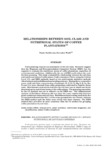Use este identificador para citar ou linkar para este item:
http://www.alice.cnptia.embrapa.br/alice/handle/doc/506306Registro completo de metadados
| Campo DC | Valor | Idioma |
|---|---|---|
| dc.contributor.author | WADT, P. G. S. | pt_BR |
| dc.date.accessioned | 2011-04-10T11:11:11Z | pt_BR |
| dc.date.available | 2011-04-10T11:11:11Z | pt_BR |
| dc.date.created | 2007-06-01 | pt_BR |
| dc.date.issued | 2005 | pt_BR |
| dc.identifier.citation | Revista Brasileira de Ciência do Solo, v. 29, n. 2, p. 227-234, maio/abr. 2005. | pt_BR |
| dc.identifier.issn | 0100-0683 (impresso) | pt_BR |
| dc.identifier.uri | http://www.alice.cnptia.embrapa.br/alice/handle/doc/506306 | pt_BR |
| dc.description | Farm planning requires an assessment of the soil class. Research suggest that the Diagnosis and Recommendation Integrated System (DRIS) has the capacity to evaluate the nutritional status of coffee plantations, regardless of environmental conditions. Additionally, the use of DRIS could reduce the costs for farm planning. This study evaluated the relationship between the soil class and nutritional status of coffee plants (Coffea canephora Pierre) using the Critical Level (CL) and DRIS methods, based on two multivariate statistical methods (discriminant and multidimensional scaling analyses). During three consecutive years, yield and foliar concentration of nutrients (N, P, K, Ca, Mg, S, B, Zn, Mn, Fe and Cu) were obtained from coffee plantations cultivated in Espírito Santo state. Discriminant analysis showed that the soil class was an important factor determining the nutritional status of the coffee plants. The grouping separation by the CL method was not as effective as the DRIS one. The bidimensional analysis of Euclidean distances did not show the same relationship between plant nutritional status and soil class. Multidimensional scaling analysis by the CL method indicated that 93.3 % of the crops grouped into one cluster, whereas the DRIS method split the fields more evenly into three clusters. The DRIS method thus proved to be more consistent than the CL method for grouping coffee plantations by soil class. | pt_BR |
| dc.language.iso | eng | eng |
| dc.rights | openAccess | eng |
| dc.subject | Coffee | pt_BR |
| dc.subject | Café Conilon | pt_BR |
| dc.subject | Classes de solos | pt_BR |
| dc.subject | Método DRIS | pt_BR |
| dc.subject | DRIS Method | pt_BR |
| dc.subject | Método do Nível Crítico | pt_BR |
| dc.subject | Level Critical Method | pt_BR |
| dc.subject | Análise multivariada | pt_BR |
| dc.subject | Análisis de multivarianza | pt_BR |
| dc.subject | Clasificación de suelos | pt_BR |
| dc.subject | Estatus nutricional | pt_BR |
| dc.subject | Nutrición de las plantas | pt_BR |
| dc.subject | Análisis estadístico | pt_BR |
| dc.title | Relationships between soil class and nutritional status of coffee plantations. | pt_BR |
| dc.type | Artigo de periódico | pt_BR |
| dc.date.updated | 2019-01-07T11:11:11Z | pt_BR |
| dc.subject.thesagro | Planejamento agrícola | pt_BR |
| dc.subject.thesagro | Café | pt_BR |
| dc.subject.thesagro | Coffea canephora | pt_BR |
| dc.subject.thesagro | Estado nutricional | pt_BR |
| dc.subject.thesagro | Classificação do solo | pt_BR |
| dc.subject.thesagro | Análise estatística | pt_BR |
| dc.subject.nalthesaurus | Plant nutrition | pt_BR |
| dc.subject.nalthesaurus | Nutritional status | pt_BR |
| dc.subject.nalthesaurus | Soil classification | pt_BR |
| dc.subject.nalthesaurus | Statistical analysis | pt_BR |
| dc.subject.nalthesaurus | Multivariate analysis | pt_BR |
| riaa.ainfo.id | 506306 | pt_BR |
| riaa.ainfo.lastupdate | 2019-01-07 -02:00:00 | pt_BR |
| dc.identifier.doi | 10.1590/S0100-06832005000200008. | pt_BR |
| dc.contributor.institution | PAULO GUILHERME SALVADOR WADT, CPAF-AC. | pt_BR |
| Aparece nas coleções: | Artigo em periódico indexado (CPAF-AC)  | |
Arquivos associados a este item:
| Arquivo | Descrição | Tamanho | Formato | |
|---|---|---|---|---|
| 15200.pdf | 50.92 kB | Adobe PDF |  Visualizar/Abrir |









